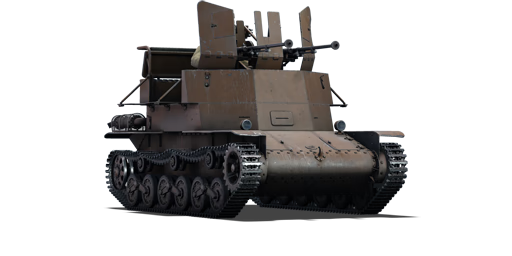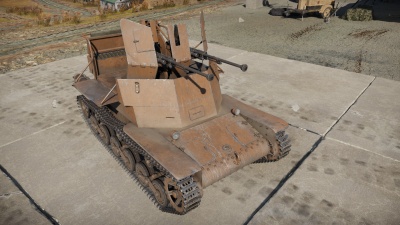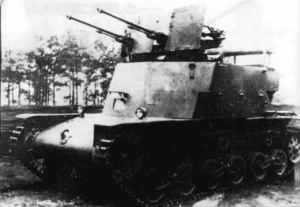Difference between revisions of "So-Ki"
m (→History) (Tag: Visual edit) |
(Updated information and media links.) |
||
| Line 2: | Line 2: | ||
== Description == | == Description == | ||
| − | + | <!--''In the description, the first part needs to be about the history of the creation and combat usage of the vehicle, as well as its key features. In the second part, tell the reader about the ground vehicle in the game. Insert the screenshot of the vehicle. If the novice player does not remember the vehicle by name, they will immediately understand what kind of vehicle it is talking about.''--> | |
| − | [[File:So-Ki Featured Image.jpg|alt=So-Ki Featured Image|left|thumb| | + | [[File:So-Ki Featured Image.jpg|alt=So-Ki Featured Image|left|thumb|400px]] |
| − | + | {{break}} | |
| − | The " | + | The "'''{{PAGENAME}}'''" is a rank {{Specs|rank}} Japanese self-propelled anti-aircraft gun (SPAAG) {{Battle-rating}}. This anti-aircraft vehicle features dual Type 98 20 mm cannons which have high-velocity capability and great mobility. |
== General info == | == General info == | ||
=== Survivability and armour === | === Survivability and armour === | ||
| − | ''Describe armour protection. Note the most well protected and key weak areas. Appreciate the layout of modules as well as the number and location of crew members. Is the level of armour protection sufficient, is the placement of modules | + | ''Describe armour protection. Note the most well protected and key weak areas. Appreciate the layout of modules as well as the number and location of crew members. Is the level of armour protection sufficient, is the placement of modules helpful for survival in combat?'' |
''If necessary use a visual template to indicate the most secure and weak zones of the armour.'' | ''If necessary use a visual template to indicate the most secure and weak zones of the armour.'' | ||
=== Mobility === | === Mobility === | ||
| − | ''Write about the mobility of the ground vehicle. Estimate the specific power and | + | ''Write about the mobility of the ground vehicle. Estimate the specific power and manoeuvrability as well as the maximum speed forward and backwards.'' |
== Armaments == | == Armaments == | ||
=== Main armament === | === Main armament === | ||
| − | ''Give the reader information about the characteristics of the main gun. Assess its effectiveness in a battle based on the reloading speed, ballistics and the power of shells. Do not forget about the | + | [[File:TYPE-98-Ho-Ki SPAAG 1.jpg|right|thumb|A three-quarter view of an early 20 mm So-Ki SPAAG.]] |
| + | ''Give the reader information about the characteristics of the main gun. Assess its effectiveness in a battle based on the reloading speed, ballistics and the power of shells. Do not forget about the flexibility of the fire, that is how quickly the cannon can be aimed at the target, open fire on it and aim at another enemy. Add a link to the main article on the gun: <code><nowiki>{{main|Name of the weapon}}</nowiki></code>. Describe in general terms the ammunition available for the main gun. Give advice on how to use them and how to fill the ammunition storage.'' | ||
=== Additional armament === | === Additional armament === | ||
| Line 24: | Line 25: | ||
=== Machine guns === | === Machine guns === | ||
| − | ''Offensive and anti-aircraft machine guns not only allow you to fight some aircraft | + | ''Offensive and anti-aircraft machine guns not only allow you to fight some aircraft but also are effective against lightly armoured vehicles. Evaluate machine guns and give recommendations on its use.'' |
== Usage in the battles == | == Usage in the battles == | ||
| Line 30: | Line 31: | ||
=== Pros and cons === | === Pros and cons === | ||
| − | + | <!--''Summarize and briefly evaluate the vehicle in terms of its characteristics and combat effectiveness. Mark its pros and cons in a bulleted list. Do not use more than 6 points for each of the characteristics. Avoid using categorical definitions such as "bad", "good" and the like - they have a substitution in the form of softer "inadequate", "effective".''--> | |
'''Pros:''' | '''Pros:''' | ||
| − | * | + | * Rapid firing cannons allow for excellent aerial coverage |
| − | * Great mobility | + | * Great vehicle mobility allowing for fast repositioning |
| − | * Frontal protection from light | + | * Frontal protection from light machinegun |
| − | * | + | * Great ammunition storage capacity |
* Fast reloading time | * Fast reloading time | ||
| − | |||
| − | |||
'''Cons:''' | '''Cons:''' | ||
| − | * Gunner crew exposed and no rear protection | + | * Gunner crew is exposed and have no rear protection |
| − | * Very vulnerable to artillery and aerial strafing/bombing | + | * Very vulnerable to incoming artillery rounds and aerial strafing/bombing |
| − | * Rapid | + | * Rapid firing easily depletes ammunition magazines, trigger control required |
| − | |||
| − | |||
== History == | == History == | ||
| − | + | <!--''Describe the history of the creation and combat usage of the ground vehicle in more detail than in the introduction. If the historical reference turns out to be too big, take it to a separate article, taking a link to an article about the vehicle and adding a block "/historical reference" (example: https://wiki.warthunder.com/Name-vehicles/historical reference) and add a link to it here using the <code>main</code> template. Be sure to include links to sources at the end of the article.''--> | |
| − | + | Prior to World War II, Japan experimented with developing a SPAAG which could be mounted to several different platforms, including trucks, tanks and railroad cars. Production ended up developing a SPAAG which could shoot down aircraft at low altitudes, however, the Japanese military wanted their SPAAGs to have the capability to also shoot down aircraft at medium altitudes too. Along with the requirement to shoot down aircraft at low and medium altitudes,m the SPAAG needed to also be highly mobile and capable of providing protection to convoys from aerial attack as a defensive vehicle also. | |
| − | Japan | + | By 1941, Japan started prototyping two variations of the new SAAG, a single mounted Type 98 20 mm cannon known as "[[Ta-Se]]" short for Taikū ("anti-air") sensha ("tank") and the "So-Ki" which featured dual-mounted Type 98 20 mm cannons. The platform which was chosen for the SPAAG was the newly built Type 98 Ke-Ni light tank with its turret removed and the dual cannon platform installed. |
| − | The | + | The crew positions of the So-Ki featured a driver situated in the centre of the vehicle and right under the anti-aircraft gun emplacement. To aid in protecting the cannon crew (gunner and loaders) a gun shield was added to block or deflect small arms fire, however, it was no match for a direct tank shell hit or strafing attack by fighters, attackers and dive bombers. A bench for the crew was mounted at the rear of the platform and could be folded out of the way to allow for placement of more ammunition magazines if necessary. |
| − | + | The total ammunition capacity for this vehicle was 22 belts plus two more already loaded in the cannons. The rate of fire for the Type-98 cannons was around 830 rounds per minute, however, velocities between rounds differed as they were comprised of different weights due to round type and explosive filler. Unfortunately, the So-Ki never entered production as by the time it was ready to enter service the needs of Japanese anti-aircraft vehicles had significantly evolved meaning the So-Ki was already outdated. The Japanese were also having a difficult time massing sufficient resources necessary for the production of this unit because of Allied progression in the Pacific front | |
| − | |||
| − | The total ammunition capacity was 22 belts | ||
| − | |||
| − | The Type | ||
| − | |||
| − | |||
| − | |||
| − | |||
== Media == | == Media == | ||
| − | ''So-Ki | + | <!--''An excellent addition to the article will be video guides, as well as screenshots from the game and photos.''--> |
| + | {{Youtube-gallery|_yh75uwKfV8|So-Ki SPAAG Vehicle Review [NUSensei]}} | ||
== Read also == | == Read also == | ||
| + | ''Links to the articles on the War Thunder Wiki that you think will be useful for the reader, for example,'' | ||
| + | * ''reference to the series of the vehicles;'' | ||
| + | * ''links to approximate analogues of other nations and research trees.'' | ||
| + | |||
== Sources == | == Sources == | ||
| − | + | <!--''Paste links to sources and external resources, such as:'' | |
| − | * | + | * ''topic on the official game forum;'' |
| + | * ''other literature.''--> | ||
| + | * [http://sensha-manual.blogspot.com/2016/12/wt-so-ki-spaa.html Review article of the So-Ki SPAAG] | ||
Revision as of 00:14, 1 May 2019
Contents
Description
The "So-Ki" is a rank II Japanese self-propelled anti-aircraft gun (SPAAG)
with a battle rating of 3.0 (AB/RB/SB). This anti-aircraft vehicle features dual Type 98 20 mm cannons which have high-velocity capability and great mobility.
General info
Survivability and armour
Describe armour protection. Note the most well protected and key weak areas. Appreciate the layout of modules as well as the number and location of crew members. Is the level of armour protection sufficient, is the placement of modules helpful for survival in combat?
If necessary use a visual template to indicate the most secure and weak zones of the armour.
Mobility
Write about the mobility of the ground vehicle. Estimate the specific power and manoeuvrability as well as the maximum speed forward and backwards.
Armaments
Main armament
Give the reader information about the characteristics of the main gun. Assess its effectiveness in a battle based on the reloading speed, ballistics and the power of shells. Do not forget about the flexibility of the fire, that is how quickly the cannon can be aimed at the target, open fire on it and aim at another enemy. Add a link to the main article on the gun: {{main|Name of the weapon}}. Describe in general terms the ammunition available for the main gun. Give advice on how to use them and how to fill the ammunition storage.
Additional armament
Some tanks are armed with several guns in one or more turrets. Evaluate the additional weaponry and give advice on its use. Describe the ammunition available for additional weaponry. Give advice on how to use them and how to fill the ammunition storage. If there is no additional weaponry remove this subsection.
Machine guns
Offensive and anti-aircraft machine guns not only allow you to fight some aircraft but also are effective against lightly armoured vehicles. Evaluate machine guns and give recommendations on its use.
Usage in the battles
Describe the tactics of playing in the vehicle, the features of using vehicles in the team and advice on tactics. Refrain from creating a "guide" - do not impose a single point of view but give the reader food for thought. Describe the most dangerous enemies and give recommendations on fighting them. If necessary, note the specifics of the game in different modes (AB, RB, SB).
Pros and cons
Pros:
- Rapid firing cannons allow for excellent aerial coverage
- Great vehicle mobility allowing for fast repositioning
- Frontal protection from light machinegun
- Great ammunition storage capacity
- Fast reloading time
Cons:
- Gunner crew is exposed and have no rear protection
- Very vulnerable to incoming artillery rounds and aerial strafing/bombing
- Rapid firing easily depletes ammunition magazines, trigger control required
History
Prior to World War II, Japan experimented with developing a SPAAG which could be mounted to several different platforms, including trucks, tanks and railroad cars. Production ended up developing a SPAAG which could shoot down aircraft at low altitudes, however, the Japanese military wanted their SPAAGs to have the capability to also shoot down aircraft at medium altitudes too. Along with the requirement to shoot down aircraft at low and medium altitudes,m the SPAAG needed to also be highly mobile and capable of providing protection to convoys from aerial attack as a defensive vehicle also.
By 1941, Japan started prototyping two variations of the new SAAG, a single mounted Type 98 20 mm cannon known as "Ta-Se" short for Taikū ("anti-air") sensha ("tank") and the "So-Ki" which featured dual-mounted Type 98 20 mm cannons. The platform which was chosen for the SPAAG was the newly built Type 98 Ke-Ni light tank with its turret removed and the dual cannon platform installed.
The crew positions of the So-Ki featured a driver situated in the centre of the vehicle and right under the anti-aircraft gun emplacement. To aid in protecting the cannon crew (gunner and loaders) a gun shield was added to block or deflect small arms fire, however, it was no match for a direct tank shell hit or strafing attack by fighters, attackers and dive bombers. A bench for the crew was mounted at the rear of the platform and could be folded out of the way to allow for placement of more ammunition magazines if necessary.
The total ammunition capacity for this vehicle was 22 belts plus two more already loaded in the cannons. The rate of fire for the Type-98 cannons was around 830 rounds per minute, however, velocities between rounds differed as they were comprised of different weights due to round type and explosive filler. Unfortunately, the So-Ki never entered production as by the time it was ready to enter service the needs of Japanese anti-aircraft vehicles had significantly evolved meaning the So-Ki was already outdated. The Japanese were also having a difficult time massing sufficient resources necessary for the production of this unit because of Allied progression in the Pacific front
Media
Read also
Links to the articles on the War Thunder Wiki that you think will be useful for the reader, for example,
- reference to the series of the vehicles;
- links to approximate analogues of other nations and research trees.






